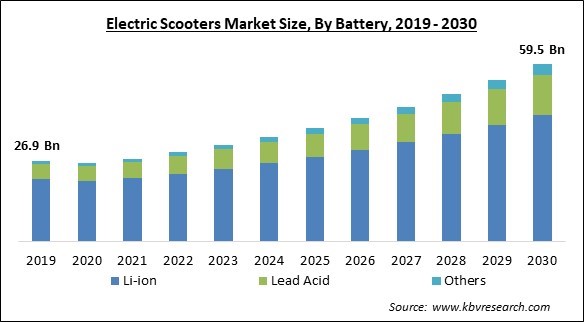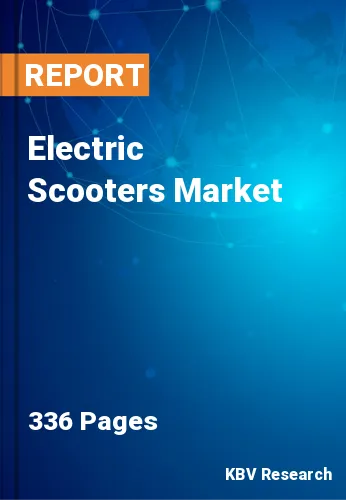The Global Electric Scooters Market size is expected to reach $59.5 billion by 2030, rising at a market growth of 9.2% CAGR during the forecast period.In the year 2022, the market attained a volume of 11,462.8 thousand units, experiencing a growth of 7.3% (2019-2022).
Electric scooters are widely brought for short distance commute. Micro-mobility solutions are often more affordable than owning a car or even using rideshare services for short trips. Therefore, the personal use segment is expected to acquire more than 3/5th share of the market by 2030. This cost-effectiveness appeals to a wide range of people, especially in urban areas where parking costs can be high. Therefore, many nations have seen a rapid increase in the sales of electric vehicles like e-scooters. For example, according to the Electric Two-Wheelers In India Report by Alliance for an Energy Efficient Economy published in June 2022, in 2021, sales of electric two-wheelers increased by more than twofold, from 1,00,736 units in 2020 to 2,33,971 units in 2021. Some of the factors impacting the market are growing demand for electric scooters owing to low maintenance cost, increasing prices of conventional fuels leading to greater demand for electric scooters, and Inadequate infrastructure for charging.

Electric two-wheelers manufacturers are anticipated to create scooters with a greater range than the present electric two-wheeler generation. Maintenance will not be an issue with fewer moving elements than traditional two-wheelers. electric scooters don't require the same variety of fluids that ICE vehicles do, such as engine oil, transmission fluid, and coolant. This eliminates the need for regular fluid checks, changes, and associated maintenance tasks. Additionally, governments are providing financial and non-financial incentives, which has caused the market to expand significantly. In light of growing low maintenance cost and demand for EVs, the electric scooters market will grow significantly. The cost of traditional fuels is rising, and consumers are adopting fuel-efficient and cost-effective alternative transportation methods. As a result, numerous governments and businesses are consistently investing in infrastructure and charging stations to encourage the adoption of electric vehicles and make it easier for users to charge their scooters. Charging electric scooters at home or at dedicated charging stations offers users convenience. They can start their rides with a full charge, without needing to find a charging station in the middle of their journey. Hence, all of these elements will accelerate the growth of the market in the coming years.
However, the absence of charging infrastructure is a significant hindrance to expanding the market. The convenience with which the vehicle may be charged virtually anywhere, at any time, is the most crucial factor for any user when acquiring an electric two-wheeler. In contrast to established countries, most developing nations lack the required charging stations. In specific areas, the limited availability of electric scooter-sharing services and the availability of sales hinder market penetration and adoption. Hence, all these elements may hamper the growth of the market in the coming years.
Based on battery, the market is bifurcated into lead acid, li-ion, and others. The li-ion segment witnessed the largest revenue share in the market in 2022. The price of Li-ion batteries is anticipated to decline, which will, consequently, lower e-scooter prices. Li-ion batteries have a high energy density, which means they can store a significant amount of energy in a relatively small and lightweight package. This makes them ideal for electric vehicles where space and weight are important considerations.
On the basis of end-use, the market is segmented into personal use and commercial use. The commercial use segment garnered a significant revenue share in the market in 2022. E-scooters are a practical and affordable last-mile delivery option for commercial applications. E-scooters may be a viable solution for quick and effective mobility in factories, universities, warehouses, and industrial sites with enormous land areas. As the trend of shared mobility gains momentum, many vehicle rental facilities are implementing e-scooters that can be rented on a per-mix or per-time basis for long-distance commutes, thereby contributing to the segment's growth.

By drive type, the market is classified into belt drive, chain drive, and hub motors. The hub motors segment held the highest revenue share in the market in 2022. Hub drives outperform their competitors regarding effective power transmission, quieter operation, and cheap repair and maintenance costs. This is encouraging major companies like Yadea Technology Group Co., Ltd., NIU International, and Yamaha Motor Corp. to offer a variety of hub drive e-scooters. This segment's rapid growth is primarily attributable to the improved durability and speed control of geared hub motors, lighter weight, reduced mechanical losses, greater flexibility, high torque at low RPMs, and the ability to double as brakes.
| Report Attribute | Details |
|---|---|
| Market size value in 2022 | USD 29.8 Billion |
| Market size forecast in 2030 | USD 59.5 Billion |
| Base Year | 2022 |
| Historical Period | 2019 to 2021 |
| Forecast Period | 2023 to 2030 |
| Revenue Growth Rate | CAGR of 9.2% from 2023 to 2030 |
| Number of Pages | 336 |
| Number of Table | 670 |
| Quantitative Data | Volume in Thousand Units; revenue in USD Million, and CAGR from 2019 to 2030 |
| Report coverage | Market Trends, Revenue Estimation and Forecast, Segmentation Analysis, Regional and Country Breakdown, Companies Strategic Developments, Company Profiling |
| Segments covered | Drive Type, Battery, End-use, Region |
| Country scope | US, Canada, Mexico, Germany, UK, France, Russia, Norway, Netherlands, China, Japan, India, South Korea, Taiwan, Malaysia, Brazil, Argentina, UAE, Saudi Arabia, South Africa, Nigeria |
| Growth Drivers |
|
| Restraints |
|
Region wise, the market is analyzed across North America, Europe, Asia Pacific and LAMEA. In 2022 the Asia pacific region led the market by generating the highest revenue share. As an automotive hub with significant sales and manufacturing in China, the region is anticipated to dominate the electric scooter market share. This development can be attributed to the rising popularity of personal mobility in the post-COVID era, which will increase the preference for automobiles. The APAC region is anticipated to be driven by rising consumer demand for affordable e-scooters for short-distance travel and government measures to encourage the usage of this form of scooter.
The market research report covers the analysis of key stakeholders of the market. Key companies profiled in the report include Gogoro, Inc., Honda Motor Co. Ltd., Jiangsu Xinri E-Vehicle Co., Ltd., AllCell Technologies LLC (BEAM Global), BMW Group (BMW Motorrad), Boxx Technologies LLC, Kinetic Green Energy & Power Solutions Ltd., Greenwit Technologies, Inc., KTM AG (PIERER Mobility AG), and Mahindra & Mahindra Limited (Mahindra Group)
Free Valuable Insights: Global Electric Scooters Market size to reach USD 59.5 Billion by 2030
By Battery (Volume, Thousand Units, USD Million, 2019-2030)
By End-use (Volume, Thousand Units, USD Million, 2019-2030)
By Drive Type (Volume, Thousand Units, USD Million, 2019-2030)
By Geography (Volume, Thousand Units, USD Million, 2019-2030)
This Market size is expected to reach $59.5 billion by 2030.
Growing demand for electric scooters owing to low maintenance cost are driving the Market in coming years, however, Inadequate infrastructure for charging restraints the growth of the Market.
Gogoro, Inc., Honda Motor Co. Ltd., Jiangsu Xinri E-Vehicle Co., Ltd., AllCell Technologies LLC (BEAM Global), BMW Group (BMW Motorrad), Boxx Technologies LLC, Kinetic Green Energy & Power Solutions Ltd., Greenwit Technologies, Inc., KTM AG (PIERER Mobility AG), and Mahindra & Mahindra Limited (Mahindra Group)
In the year 2022, the market attained a volume of 11,462.8 thousand units, experiencing a growth of 7.3% (2019-2022).
The Personal Use segment is leading the Market by End-use in 2022; thereby, achieving a market value of $39.0 billion by 2030.
The North America region dominated the Market by Region in 2022, and would continue to be a dominant market till 2030; thereby, achieving a market value of $8.6 billion by 2030.
Our team of dedicated experts can provide you with attractive expansion opportunities for your business.

